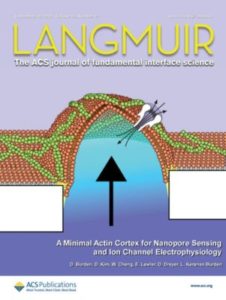Designing Synthetic Cell Components
All cells in all domains of life possess a cytoskeleton that provides mechanical resistance to deformation and general stability to the plasma membrane. We are developing approaches that chemically couple minimalistic support structures to lipid membranes for the purposes of nanopore sensing.

Robust biomembranes are needed for nanopore sensors that have potential application in DNA sequencing and clinical microbiology. Our findings show an actin support network attached to a lipid bilayer increases the apparent elastic modulus by >102, compared to unmodified membranes. The web-like support structure retains the lateral fluidity of the bilayer, maintains high electrical resistance, enables relatively uninhibited molecular access to the lipid surface from bulk solution, and permits nanopore self-assembly and insertion in the bilayer.
Ongoing studies include filament layering and cross-linking properties, alterations in lipid dynamics, and the durability of membranes derivatized with actin filaments. Featured here is a multi-layered cross-linked actin cortex that is chemically bound to a lipid bilayer. The thickness of the structure is less than 1 micron. This thin layer provides ready access to analytes from bulk solution, adds mechanical stability, and protects the membrane from degradation under non-ambient conditions.


